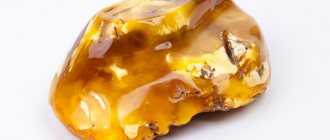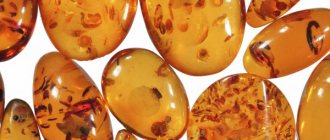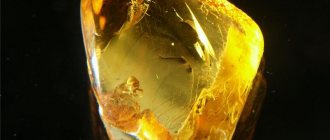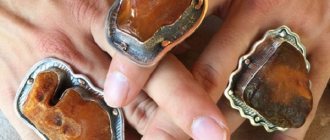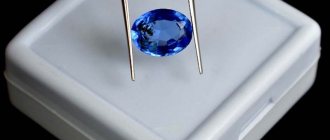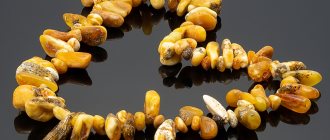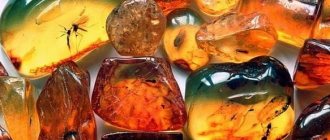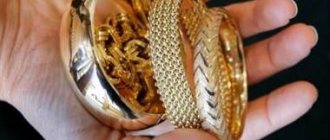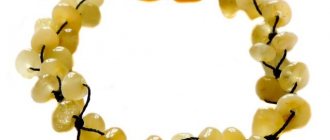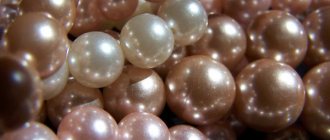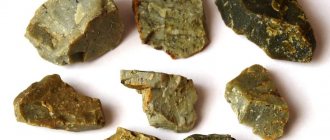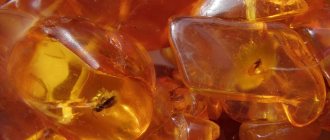- What is pressed amber?
- Processing process - subtleties and secrets
- Types, features and characteristics of ambroid
- What is made from reconstructed amber?
Solar gems are highly valued due to their wonderful range and variety of textures. Their medicinal properties deserve no less admiration. Therefore, craftsmen try to use even very tiny particles of frozen resin as efficiently as possible. And our article will tell you about the amazing technology that turns miniature cabochons into a magnificent decoration!
What is pressed amber?
Industrial mining of gold stones is not an easy task. Only 10-20% of raw materials extracted from the bowels of the earth are suitable for creating accessories (it is also called “ornamental”). The remaining pieces of cured resin are too small, dirty, or the wrong shape. A lot of waste also appears after processing large gems. What to do with these grains?
The first such experiments were described by the ancient Romans. Knowing about the flammability of cabochons, craftsmen boiled them in honey or heated them in special crucibles, trying to combine individual stones into a single whole. However, most often these studies ended in failure - the amber darkened or cracked. In the Middle Ages, similar experiments were carried out by the Arabs, but also without success.
Only in the XVIII century. scientists have found that hardened resin softens at a temperature of 240-280 °C and a pressure of 25 to 60 MPa (about 2500-2700 kg/cm2). Ambroid cabochons obtained in this way retain all the chemical and physical properties of natural gems. But at the same time, they can take on any configuration - it all depends on the container into which the hot mixture was poured. Therefore, pressed gemstones are in no way counterfeit - they are 100% natural amber, which has simply been reconstructed.
| Products made from solid amber | ||
Annealing
This method improves the decorative properties of natural pieces of amber. Raw amber is placed in specialized furnaces with sand and subjected to intense heat at temperatures above 200 C. As a result, the stone becomes transparent due to the fact that gas bubbles that cloud the amber come out of it. When heated for a long time, the shade of amber becomes golden yellow. At the same time, numerous cracks form inside the gem, which makes the stone “shiny” when light passing through the stone is refracted through them.
In addition to refining the amber, each stone undergoes standard processing, which includes: peeling, cutting, shaping, grinding and polishing.
Types, features and characteristics of ambroid
Products made from natural hardened resin are divided into the following groups:
- solid (from a monolithic precious stone);
- molded (from several small gems);
- pressed , or reconstructed (from small crumbs).
However, regardless of the variety, high-quality products consist only of natural amber, without any inclusions. This means that they retain all the benefits of naturally occurring cabochons! Here are some advantages of ambroid gizmos:
- rich, rich palette - its shades vary from the usual yellow-orange to cream, olive, crimson and dark chestnut;
- original texture - by combining amber flour with different colors, the master can create transparent or matte, completely monochromatic or rather variegated stones;
- durability - the latest technologies make it possible to obtain a very durable gem that almost does not suffer from oxidation and photoaging (changes in tone due to the influence of sunlight);
- environmental safety - no glue, aldehydes, polymers or other harmful chemicals are used in the production of ambroid;
- low cost (rational use of resources reduces the cost of the final product).
Therefore, the problem of how to distinguish pressed amber from natural one is almost irrelevant - both materials are equally beautiful and reliable, have identical density, fragility and refractive index. Often even qualified jewelers are unable to recognize them! In order to determine exactly what a cabochon is made of, it is necessary to carry out an ultraviolet test or drop ether onto the surface of the gemstone; a visual inspection, as well as testing the hardness, electrification or flammability of a gem, will demonstrate only the complete identity of the whole and reconstructed hardened resin.
Previously, there was an opinion that ambroid could be easily recognized by its uneven structure, but such defects are a consequence of failure to follow the correct technology. For example, if the pressure was uneven, or if excess oxygen was supplied to the container with amber flour, accumulations of air bubbles would form inside the cabochons. And when dye is added to crushed gems, areas with a brighter shade appear in the finished specimens - clumps of pigment that have not dissolved in the viscous resin. Good pressed stones are devoid of such disadvantages - the only thing that distinguishes them from natural ones is their favorable price.
| Muslim rosary made of pressed amber | |
Acrylic
Polymethyl methacrylate has been known for quite some time. This is quite ordinary organic glass, otherwise called plexiglass or simply acrylic. During the Second World War, transparent elements of aircraft cabins were made from plexiglass. Nowadays, bathtubs are made from milky-colored acrylic, and imitation amber is made from transparent plastic tinted the color of honey. You can mistake acrylic “amber” for real only from afar or in a photo. The artificiality of the material is too obvious. The hand-made nature of internal defects and inclusions is too noticeable. Acrylic is deliberately shiny, and the shape of its beads is perfectly standard. However, acrylic products can mislead an uninitiated person. Modern methods of making counterfeits sometimes achieve their goal. Acrylic “amber” - especially in photos and videos - looks not just like real, but like jewelry amber of exemplary quality. There have been cases of falsification of premium jewelry with acrylic. Copying models of famous designers, scammers exactly repeat the shape of gold and silver frames and simulate the expressiveness of an amber cabochon. Such counterfeits are advertised via the Internet and sold by mail. In the videos, amber-like acrylic and “samovar gold” look extremely presentable. The products also look good in kind - for a short time... However, the very first visit to the jeweler makes the situation clear: costume jewelry, even of particularly high quality, does not cost as much as natural amber in a gold frame.
What is made from reconstructed amber?
The range of ambroid products is very wide. First of all, this material is extremely popular in jewelry: any items are made from it, from modest pendants to massive brooches, beads and necklaces. Plastic hardened resin easily takes the desired shape, so with its help the master can realize even those design projects that are not feasible with ordinary gems. In particular, pressed gems produce magnificent and detailed cameos, figurines, and patterned pendants. Smoothly polished works look no less impressive - rounded cabochons in earrings or rings, beads in necklaces and bracelets.
Ambroid looks excellent against the background of noble metals (especially icy sparkling silver), and next to other precious stones, and framed in wood, fabric, and leather. This means that you can easily find a thing that will fit into your image, be it discreet classic, bold grunge, relaxed boho or comfortable casual!
In addition to jewelry needs, ambroid is in demand in:
- medicine. The essential resins and oils released by solar gems prevent the destruction of red blood cells, so instruments made from this material are ideal for storing and transfusing blood. They also have antiseptic and bactericidal effects;
- instrument making (pressed cabochons are used to make parts for radios, X-ray machines, brake mechanisms, airplanes, trains and even space equipment);
- electrical engineering (amber is a good current insulator);
- everyday life (the master is able to cast any thing from molten resin - from a button, pipe mouthpiece or cigarette case to a plate, watch case, lamp or box).
| Pressed amber bracelets | |
And our online store will help you purchase high-quality and presentable pressed amber! The exclusive beads and bracelets made of shimmering ambroid presented here will become the “highlight” of any outfit, add elegant sophistication and charm to your image, and share the beneficial energy and warmth of solar gems.
Pressed turquoise as a response to increased market demand
Turquoise has been a mineral beloved by all peoples since ancient times. For many centuries it has remained in demand and popular, and therefore, despite the fact that this rock is not considered rare, today natural high-quality stones are not often found on the market. Time passes, existing mines are depleted, and the development of new ones is carried out inactively - it is not always economically profitable, since it is typical for gemstones to occur in small quantities.
And, nevertheless, the needs of the market must be satisfied, and therefore jewelers resort to various tricks. One such trick is pressed turquoise. Let us immediately note that the answer to the question of whether it is natural will be positive, but this is a natural stone of the lowest quality existing on the market.
Celluloid
It was invented in America in the second half of the 19th century. Celluloid was patented by John Wesley Hite. Initially, its goal was to imitate natural ivory, but later, from nitrate cellulose, camphor and colloidal paints, it was possible to obtain a product that could be successfully passed off as amber.
Celluloid, made to look like amber, was used as decorative finishes on tableware. It is produced in the form of plates, the texture of which is very similar to amber. But it gives itself away as too bright, “screaming” colors, which indicate its artificial origin.
An interesting fact is that celluloid is now produced in very limited quantities due to the flammability and unsafety of this material. It is not so easy to see celluloid fakes of amber in retail sale.
Bakelite
This artificial stone was invented by the American chemist Leo Backland: he treated phenol with formaldehyde, and the world's first synthetic plastic was obtained. Backland himself did this experiment simply out of curiosity and not at all so that the material he created would be used to make amber fakes. However, fate decreed otherwise.
Initially, bakelite plastic became widespread in the manufacture of spare parts for various devices, as well as their housings - in the field of mechanical engineering and electrical engineering. Bakelite was successfully used to produce brake pads, adhesives and construction varnish.
In Germany, bakelite, along with polyburnum, found its use in the manufacture of jewelry “like amber.” The invention of Bakelite happened just at the time when the First World War ended. People did not have the financial ability to buy expensive jewelry made from natural stones. That is why the synthesis of “analogs” from plastic has become so widespread.
Phenol-formaldehyde resin itself has no color, but if you introduce some impurities into it and apply simple processing technologies to it, it acquires a beautiful, amber-yellow color. Thus, the markets of all European countries were soon filled with bakelite products “under amber”. By the way, a famous one has adopted this technology. Now the company actively uses bakelite in the manufacture of its famous pens.
Bernit
Bernite may contain a small percentage of amber substance - about 5%. Large jewelry companies have long abandoned the imitation of amber using it. The artificial bernite stone itself is often painted in different colors and sold as an independent product, which is in good demand. However, those polyester compounds that are present in bernite can “pass” well as transparent honey amber. Defects are still artificially created in bernite, making it difficult to distinguish it from amber with the naked eye.
Initially, the production of bernites looked like this: amber powder was mixed (sintered) with polyester resin. Under conditions of the process occurring in an oxygen environment, the color of the stone turned out to be yellowish with a red tint, and if it was heated in a nitrogen environment, it turned green. Today, the range of bernite products is very wide, with virtually the entire color range available. It may also happen that prices for amber will rise significantly, which means that the number of fakes made of burnite will also increase.
dug
By its nature, it is in many ways reminiscent of amber, because it is a hardened tree resin, but the resin of amber comes from conifers, and not from leguminous plants. In addition, amber has existed for millions of years, and copal hardly exceeds the “age” of only 1000.
Externally, copal can be impossible to distinguish from amber, especially from some of its varieties. Autoclaving using various chemicals increases the density and hardness of the legume resin. One of the most common ways to attract buyers is the “art” of introducing some insect into a liquid resinous drop, and then saying that this is the work of nature itself.
Checking inclusions
Inclusions are suspicious if the insect inside is frozen in a static position and looks dead. This means that's how it got there. Living insects, stuck in amber, freeze in it in dynamic poses - with open wings and raised paws.
Checking inclusions
You should be suspicious of too many inclusions being sold at a low price. Especially those that contain lizards or large flies similar to modern ones. But insects have changed little in 50 million years, and there is a possibility that a modern-looking fly is still ancient.
Polyburn
This is an artificial stone that was created in Soviet times in the GDR from amber chips held together with epoxy (polyester) resin. It was she who gave the small pieces of amber bright colors, which were approved by the leadership of the German Communist Party. In a short time, polyburn production became widespread. The name of the stone itself comes from the names of its two components: “bern” was taken from “bernstein” (amber), and “poly” are the first letters denoting the name of the resin that held the amber pieces together.
During the era of intensive production of Polyburn, many decorations with inserts from this material were produced, as well as interesting interior items. But very soon polyburne went out of fashion, because its quality directly depended on what fragments of amber went into production. Therefore, it has become impossible to produce products with a stable guarantee of the same quality.
Despite this, the technology has not completely sunk into oblivion: even now in the Eastern part of Germany and in some Western European countries there are laboratories and enterprises producing small batches of polyburn.
Faturan
This material was invented a long time ago and deserves some respect. It was created in the 17th century, when Eastern craftsmen processed amber dust and shavings, mixed them with resins of various origins, and then heated and pressed them. This is how faturan turned out. Products made from faturan are distinguished by their amazing beauty: their color is honey-red with a wonderful matte tint. Unfortunately, the production technology was lost, and it is no longer possible to restore the original methods of producing faturan.
But when Bakelite became a powerful commercial success in Europe, a certain Dr. Thrawn from Hamburg modified it in ingenious ways, giving it a resemblance to faturan. Thrawn simply tinted the stone, and the fraudulent plan was a success. Thrawn's company was actively engaged in the manufacture of faturan counterfeits until the early forties of the last century and supplied them to the East. Modern “craftsmen” are still engaged in this fraud, counterfeiting both amber and faturan by mixing who knows what synthetic materials.
